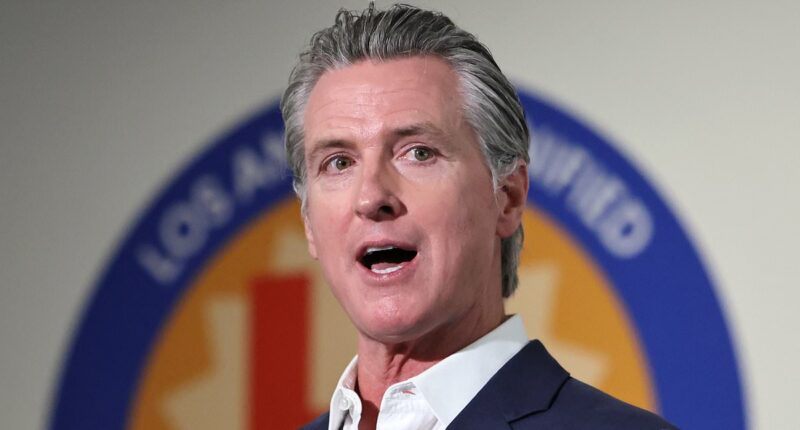Share this @internewscast.com
California Governor Gavin Newsom has declared war on schoolkids’ favorite school lunches with a new ultra-processed food ban.
The Real Food, Healthy Kids Act, known as Assembly Bill 1264, was approved on Wednesday, positioning California as a leader in battling ultra-processed foods (UPF).
This law is the first of its kind in the United States to define UPF legally and will initiate the gradual removal of these foods, which contain artificial ingredients and high amounts of saturated fats, sodium, and sugar, among other components.
Student-favored foods like hot dogs, chips, and pizza could be under threat by California’s new law.
On average, ultra-processed foods make up 62% of children’s daily calorie intake in the U.S. These foods have been associated with health issues such as cancer, heart disease, and diabetes.
Under the new legislation, California’s Department of Public Health must establish guidelines by mid-2028 to identify ‘ultra-processed foods of concern’ and ‘restricted school foods.’
‘California has always taken the lead when it comes to children’s health,’ stated Newsom, 57, emphasizing the state’s proactive role in eliminating harmful additives and enhancing school nutrition over the years.
‘This pioneering law continues our efforts to ensure every student in California has access to nutritious and tasty meals that support their well-being,’ he added.

California Governor Gavin Newsom passed The Real Food, Healthy Kids Act, also known as Assembly Bill 1264, on Wednesday, bringing California to the forefront of the war against ultra-processed foods

The bill is the first in the nation that will provide a statutory definition of UPF and will begin phasing these foods, which include artificial flavors and colors , thickeners and emulsifiers, high levels of saturated fats, sodium, and sugar, and more
‘DC politicians can talk all day about ‘Making America Healthy Again,’ but we’ve been walking the walk on boosting nutrition and removing toxic additives and dyes for decades,’ he wrote on X.
Schools have to start phasing out those foods by July 2029, and districts will be barred from selling them for breakfast or lunch by July 2035. Vendors will be banned from providing the ‘foods of concern’ to schools by 2032.
Newsom had previously signed the California School Food Safety Act, which banned food dyes Red 40, Yellow 5, Yellow 6, Blue 1, Blue 2, and Green 3 in meals, drinks, and snacks served in most K-12 school cafeterias across the state.
‘With this legislation, Democrats and Republicans are joining forces to prioritize the health and safety of our children. We’re proud to once again lead the nation with a bipartisan, science-based approach,’ Assemblyman Jesse Gabriel, who has penned several bills for healthier food in schools, said.
Newsom’s wife, Jennifer Siebel, was also at the press conference to celebrate the new bill. She said a healthy lunch at school was important as it may be the only meal a student gets in a day.
‘By removing the most concerning ultra-processed foods, we’re helping children stay nourished, focused, and ready to learn,’ she said in a statement.
Some school districts in California are already phasing out foods the new law seeks to ban.
Michael Jochner spent years working as a chef before taking over as director of student nutrition at the Morgan Hill Unified School District about eight years ago. He fully supports the ban.

‘California has never waited for Washington or anyone else to lead on kids’ health. We’ve been out front for years, removing harmful additives and improving school nutrition,’ Newsom said

Schools have to start phasing out those foods by July 2029, and districts will be barred from selling them for breakfast or lunch by July 2035. Vendors will be banned from providing the ‘foods of concern’ to schools by 2032
‘It was really during COVID that I started to think about where we were purchasing our produce from and going to those farmers who were also struggling,’ he said.
Now they don’t serve any UPFs, and all their items are organic and sourced within about 50 miles of the district, Jochner said.
They removed sugary cereals, fruit juices and flavored milks, and deep-fried foods such as chicken nuggets and tater tots from their menus, he said.
Many of their dishes are made from scratch or semi-homemade, including an item that has long been a staple in US school cafeterias: Pizza.
Pizza is also a popular option for students in the Western Placer Unified district northeast of Sacramento, where Director of Food Services Christina Lawson has spent the past few years introducing more meals made from scratch to their school menus.
She estimates up to 60 percent of school menus in the district are made up of dishes made from scratch, up from about 5 percent three years ago.
They also purchase more foods locally to prepare a wide variety of items, including buffalo chicken quesadillas using tortillas made in nearby Nevada City.
‘I’m really excited about this new law because it will just make it where there’s even more options and even more variety and even better products that we can offer our students,’ Lawson said.

Newsom had previously signed the California School Food Safety Act , which banned food dyes Red 40, Yellow 5, Yellow 6, Blue 1, Blue 2, and Green 3 in meals, drinks, and snacks served in most K-12 school cafeterias across the state
‘Because variety is the number one thing our students are looking for.’
Dr. Ravinder Khaira, a pediatrician in Sacramento who supports the law, said at a legislative hearing that the ban will help respond to a surge of chronic conditions in children fueled by poor nutrition.
‘Children deserve real access to food that is nutritious and supports their physical, emotional and cognitive development,’ Khaira said. ‘Schools should be safe havens, not a source of chronic disease.’
However, some worry this will raise prices on food for school district forced to buy the more expensive option, or it will ban some healthy options.
The California School Boards Association is concerned about the cost for districts to phase out these foods in the next few years. There is no extra money attached to the bill.
‘You’re borrowing money from other areas of need to pay for this new mandate,’ spokesperson Troy Flint said.
The law could raise costs for school districts by an unknown amount by potentially making them purchase more expensive options, according to an analysis by the Senate Appropriations Committee.
Legislatures across the country have introduced more than 100 bills in recent months seeking to ban or require labeling of chemicals that make up many ultra-processed foods, including artificial dyes and controversial additives.
Americans get more than half their calories from UPFs, which have been linked to a host of health problems, including obesity, diabetes and heart disease. However, studies haven’t been able to prove that the foods directly cause those chronic health problems.

![Julia Roberts Stars In A #MeToo Drama That Wastes Its Potential [NYFF 2025]](https://internewscast.com/wp-content/uploads/2025/10/Julia-Roberts-Stars-In-A-MeToo-Drama-That-Wastes-Its-200x110.jpg)















